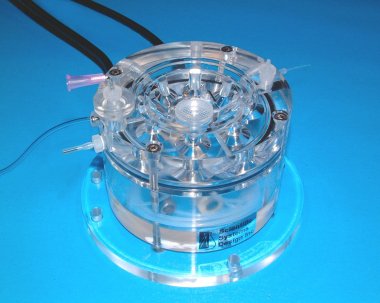
The BSC1 chamber design is similar to the original "Oslo chamber" (Langmoen & Andersen 1981) with later modifications (Dhanjal & Sears 1980, Alger et al, 1984) to allow both interface and submerged methods of slice maintenance.
- "Submerged" and "Interface" methods of slice maintenance with same chamber
This chamber allows adaptation to either method of slice maintenance simply by altering the fluid level by means of a screw adjustment device on the chamber.
- Slices supported on removeable insert adaptable to your requirements
A standard insert having a nylon net is supplied with the chamber for submerged and interface methods. This insert can be modified or custom made to accommodate other preparations eg. adult spinal cord (Dhanjal & Sears 1980, Alger et al, 1984) and Cerebellar slices (Crepel et al 1981).
- Proportional Temperature Controller (PTC03) with low noise performance
The temperature is controlled by a proportional control heating unit, the PTC03 which provides smooth DC controlled power to the heater element incorporated into the chamber.
The chamber is constructed from clear acrylic having a diameter of 100mm, height is 85mm and the base plate is 130mm in diameter. The slices rest on a nylon net fixed on to a removable insert, located in the centre of the chamber. Pre-oxygenated medium enters the main body of the chamber through a fine bore tube which spirals in the heated distilled water in the lower part of the chamber and enters the upper part of the chamber via a bubble trap. Depending on whether submerged or interface type preparations are required, the height of the perfusion fluid is adjusted at the exit well by means of a needle on a screw mechanism. In the case of interface preparations, the high oxygen tension is maintained by bubbling a 95% oxygen, 5% carbon dioxide gas mixture through a ceramic bubbler located in the lower heated part of the chamber. This moistened and warmed gas mixture enters the upper part of the chamber via "port holes" and is then deflected by a profiled lid across and downwards towards the centrally located slice preparation. The temperature in the upper chamber is maintained by ensuring that the medium and moistened gas mixture enter at the required temperature. This is dependent on the temperature of the lower chamber body which is warmed by a heating element controlled by the Proportional Temperature Controller, PTC03. An optional monitor sensor allows the upper chamber temperature to be checked when required.

